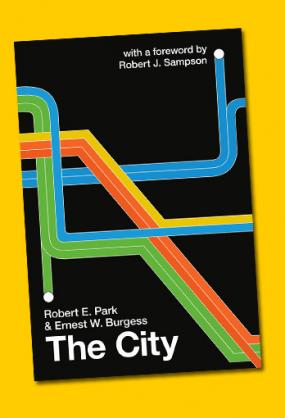The city is not just its skyscrapers and sidewalks, its roads, or houses or people. The city is “a state of mind”—a result of the interactions between institutions and those who inhabit them.
That was part of the argument Robert E. Park laid out nearly a century ago, when he co-authored The City with fellow University of Chicago sociologist Ernest W. Burgess. Published in 1925, the book became a seminal text for the Chicago school of sociology, recasting the city itself as a lab for holistic, data-driven research. It was this approach that cemented the two scholars as pioneers in their field, formalizing a methodological framework that shaped sociology for decades to come.
On April 4, a faculty panel will examine the legacy and impact of The City, which the University of Chicago Press is republishing the same month. Co-sponsored by the Mansueto Institute for Urban Innovation, the Division of Social Sciences and the University Library, the 5 p.m. event at Regenstein Library will feature UChicago scholars Luís Bettencourt and Kathleen Cagney, as well as Harvard University’s Robert Sampson—a former UChicago faculty member.
The discussion—which also includes Robert Vargas, a Neubauer Assistant Professor in Sociology, and Assoc. Prof. Nicole Marwell in the School of Social Service Administration—will explore how The City helped establish the field of urban sociology, and serve as a forum for examining the discipline’s present and future.
“What’s special about the book is that it’s very forward-looking,” said Bettencourt, the Pritzker Director of the Mansueto Institute, which develops research to advance sustainable urban development. “It’s a proposal for how to think about cities.”
Bettencourt first encountered The City through Burgess’ theory of concentric zones, which mapped a city from its central business district out to factory, residential and commuter zones. Though imperfect, the map still stands as one of the first theoretical models in urban sociology and an entry point for the structure of cities in space.
These larger ideas are what make The City relevant, even in the 21st century. Though technology has advanced since its publication, the book still provides a frame of reference to understand how communities bind together or drift apart.
“We’re really rethinking how we understand urban space,” said Cagney, deputy dean of the Division of the Social Sciences and Professor of Sociology. “A concern among social scientists is that you have all these big data or found data—these opportunities to characterize urban social structure. But one doesn’t want to move through that space atheoretically.”
Bettencourt, whose research on cities spans from Chicago to India to the Galápagos Islands, sees global applications for Park and Burgess’ book. The City was first published in the midst of an American urban boom. By 1930, more than 56 percent of the country’s population lived in urban areas. Last year, the United Nations estimated that 55 percent of the world’s population lived in urban areas—a number projected to grow to 68 percent by 2050.
“This book is still relevant because it describes a city that is balancing development with pollution, poverty and exclusion,” Bettencourt said. “That’s true of any city, but it’s particularly poignant in cities that are growing and changing fast.”
While some of what Park and Burgess espoused might feel outdated, their vision can still inspire today’s scholars to think big and provoke new conversations. In his foreword to the new edition, Sampson acknowledged the book’s critics, but argued for “the value of the underlying ideas and the larger theoretical picture.”
“If nothing else, The City asks great questions and shows how a foundational research project was carried out,” wrote Sampson, a UChicago professor from 1991-2002. “A new generation of readers can now find their own nuggets of Park and Burgess to argue with, their own disagreements to advance, their own parts of the book to revise and overturn. ...
“What more can one ask from a book?”
